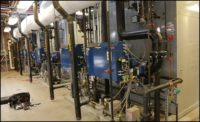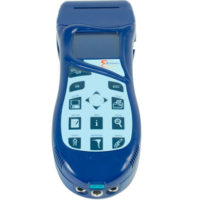For new installations and annual maintenance, the combustion analyzer has become a critical tool for HVAC professionals. Used for both furnaces and boilers, the basic hand-held device measures carbon dioxide, carbon monoxide, oxygen, and stack temperature. More advanced models may have added features that provide gas and draft pressures, two temperatures instead of one, and the ability to conduct a heat exchanger test. Some even provide delta T figures to measure the temperature differential in cooling systems.
The analyzer provides significant benefits for contractors and their customers in both the residential and industrial/commercial markets. For fleet owners, working with standardized equipment on a common platform provides operational efficiencies and improved performance that can increase overall profitability in a highly competitive HVAC environment.
Safety is no doubt the primary reason for using a combustion analyzer. Some problems cannot be detected without the aid of this device. For example, hairline cracks can cause carbon monoxide to leak from furnaces, replacing the oxygen in the air. The analyzer can detect these leaks and monitor them for danger. This sensitive instrument can pick up the slightest trace of harmful gases that might indicate potential problems down the road. By measuring oxygen levels for installations and maintenance, the technician can produce a proper flame and maintain the right level of carbon monoxide in the stack.
Efficiency is another key reason for using a combustion analyzer. It can help ensure that boilers and furnaces are operating at optimal efficiency and not allowing heat to escape from the stack. These accurate measures can help provide significant fuel cost savings for HVAC customers.
The analyzer also helps technicians work more efficiently. They can quickly diagnose problems and make necessary repairs or adjustments without wasting valuable time.
Product Standardization Benefits Fleet Owners
Successful HVAC fleet owners know that product standardization can provide significant operating benefits and cost savings in capital investments. In the case of combustion analyzers, manufacturers may offer bulk discounts and special offers to buyers, but the benefits go beyond the initial investment.
First and foremost, all the technicians in the fleet are trained on a common platform. Depending on the size of the fleet, a manufacturer may conduct on-site, hands-on group training on the use, care, calibration, and maintenance of the combustion analyzer. Regulatory training may also be provided for fleet owners in the commercial/industrial segments.
Working with one family of instruments, technicians can often support each other while in the field — answering questions, solving problems, and providing assistance. Working on a common platform, they can also borrow instruments from each other if one is down. If the fleet owner needs units with expanded capabilities for specific applications, they can purchase a limited number of more advanced combustion analyzers that can be shared across the fleet.
Standardization is also a benefit and a selling point for customers. No matter which technician performs the annual service, the customer always receives the same information and data in the same format. Customers are better able to understand and rely on the printed reports they receive every time service is performed. This reliability and consistency provides confidence in the work and professionalism of the entire HVAC fleet.
For fleet owners in the commercial and industrial market, software options can be customized for regulatory and company-specific requirements.
Service and Maintenance Benefits Provided with Common Platform
HVAC contractors can also save time and money on annual maintenance of their combustion analyzers. In the traditional service path, the entire unit can be sent in for annual maintenance.
Some manufacturers offer a sensor replacement program, whereby the owner receives a new pre-calibrated sensor that can be plugged into the unit, keeping it in the field, while simply sending back the old sensor to the manufacturer. Sensor exchange programs keep units operating without costly delays for service and repair.
Annual calibrations should be scheduled at the start of the heating season. To keep the fleet active, common spare parts including probes, printers, paper, water traps, and filters should be kept on hand. Owners are advised to be cautious about who performs repairs and maintenance. Direct factory, or factory-authorized service, is the best guarantee that all maintenance and repairs are performed to the highest quality standards.
Fleet owners report that they have seen their business grow with the use of combustion analyzers. Training on a common platform and repetitive experience in the field improves efficiency during calls as work can be done faster and more cost-effectively. Analyzers provide immediate combustion performance information to the technician that initiates efficient repairs. The data obtained from the analyzer can help to explain the cost of ownership and energy savings should the furnace or boiler need replacing. Their customers feel safer and more secure knowing their boilers, furnaces, or cooling systems are operating at peak performance.




